Whether you’re a dedicated foodie or simply looking for an authentic Italian experience on your next visit, then you need to know about truffles. One of the most coveted (and delicious!) foods in the world, you’ll find some of the finest truffles in Italy. Though they can be cultivated, the most desirable truffles grow wild, and they aren’t easy to track down. That’s why truffle hunting in Italy is such a fascinating and exciting experience.
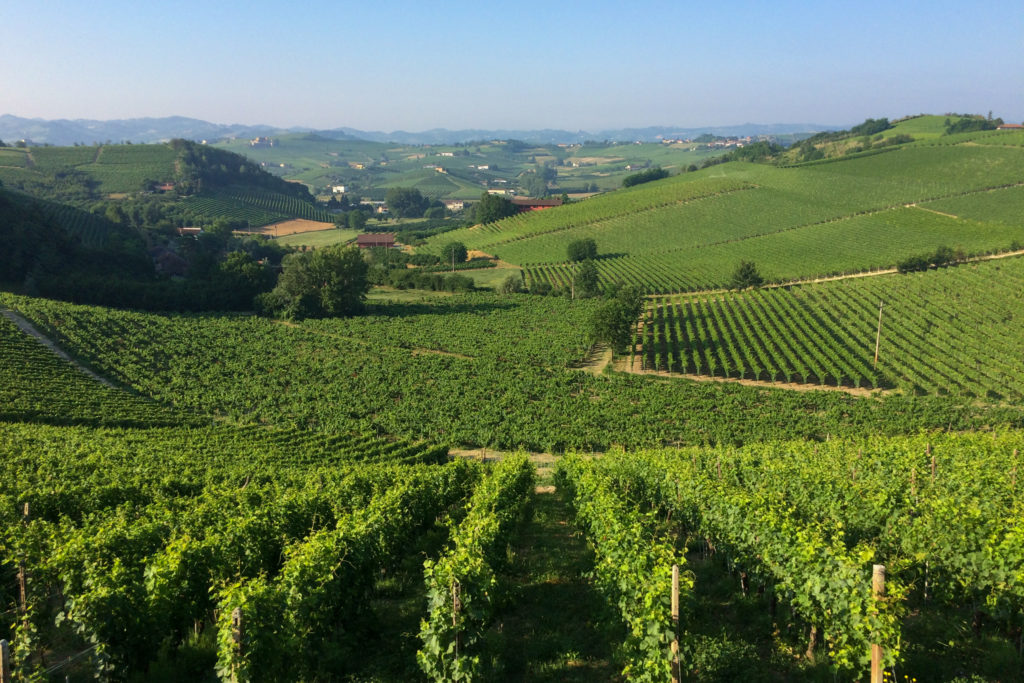
This post contains affiliate links, this means that I may receive a commission at no cost to you if you click a link and make a purchase.
Catherine lives for part of the year in the Piedmont region of Italy. It’s the epicentre for the most revered truffle of them all, the fabled Alba white truffle. As the Italian black truffle grows here too, the Piedmont truffle season extends across most of the year. This makes it a great place to go truffle hunting in Italy!
In this blog post Catherine gives you the lowdown on everything you need to know to plan your own truffle tour in Piedmont. You can also read about Catherine’s visit to the Italian Lakes here.
Truffles in Italy
Truffles (or tartufi) are one of the most expensive foods on the planet, up there with caviar and oysters. These knobbly little tubers are the edible fruiting body of a type of fungus, a bit like mushrooms. But unlike mushrooms, truffles are rare.
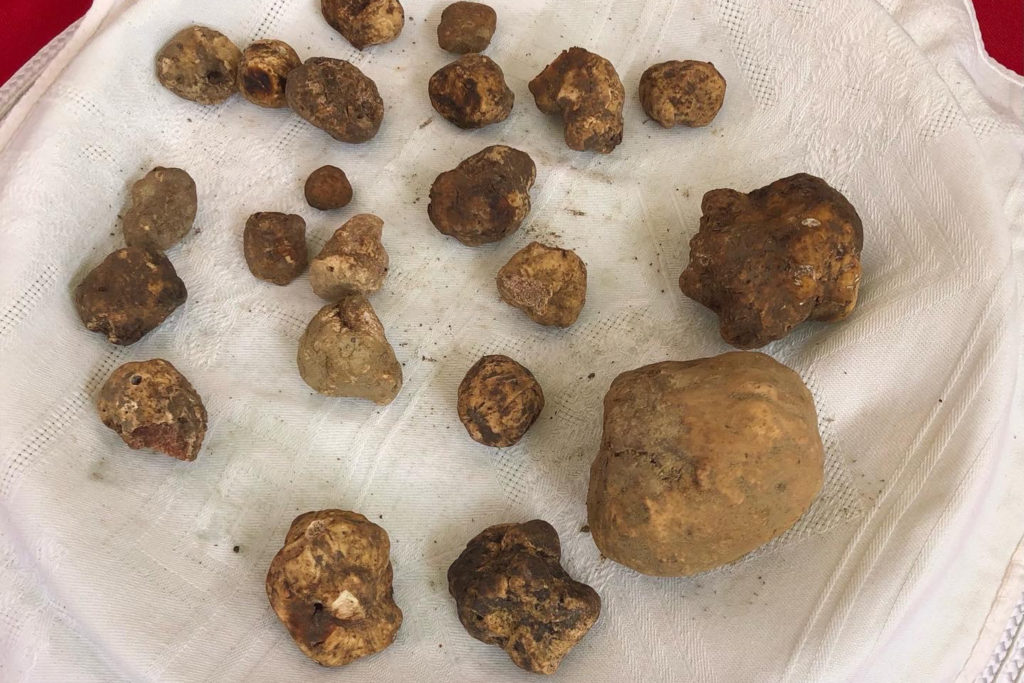
Truffles only grow underground in certain soil conditions, in particular micro-climates and close to tree roots. In fact they have a symbiotic relationship with the trees they grow beneath. They take years to establish. And once uprooted, they have a very short shelf-life. And the only way to find them is to literally sniff them out. No wonder truffles are highly prized – and highly priced! Some truffles are cultivated nowadays, allowing commercial truffle production, but really you can’t beat the real thing. A freshly dug truffle that you can carry home and eat for lunch!
Why are Italian truffles so sought after?
Truffles have an intense aroma and earthy, complex flavours that add richness to dishes. Which is why they are revered as a delicacy all over the world. In the wild, they grow mainly in France, Spain and Italy, though they are also found in other countries around the world. The ancient Romans loved tartufi, they linked them to the god Jupiter, famed for his sexual prowess, and claimed they had aphrodisiac properties. And in fact truffles do emit a pheromone-type scent – so perhaps the Romans were onto something.
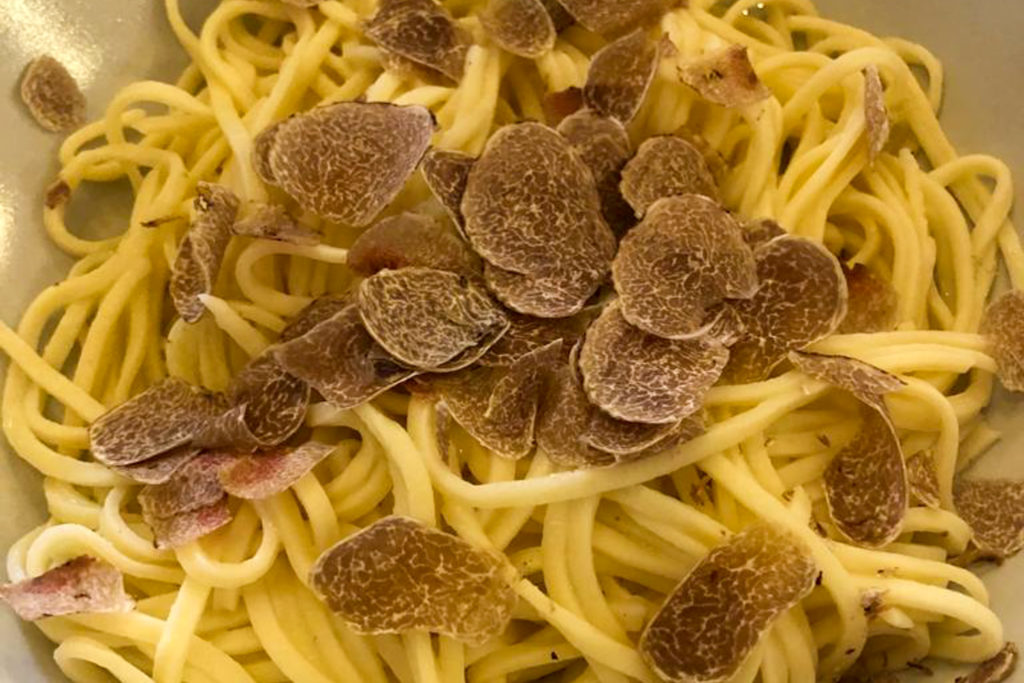
Varieties of truffles
The black truffle, Tuber melanosporum, is the best known of the many varieties of truffles. As with all truffles, it is prized as a raw garnish to dishes and a little goes a long way. But it is also robust enough to withstand a small amount of cooking to enhance flavours. It can be cultivated but traditionally grows wild in central Italy and France as well as Piedmont. Italian black truffles have a textured, bumpy surface that’s dark brown or black with a smooth black marbled flesh.
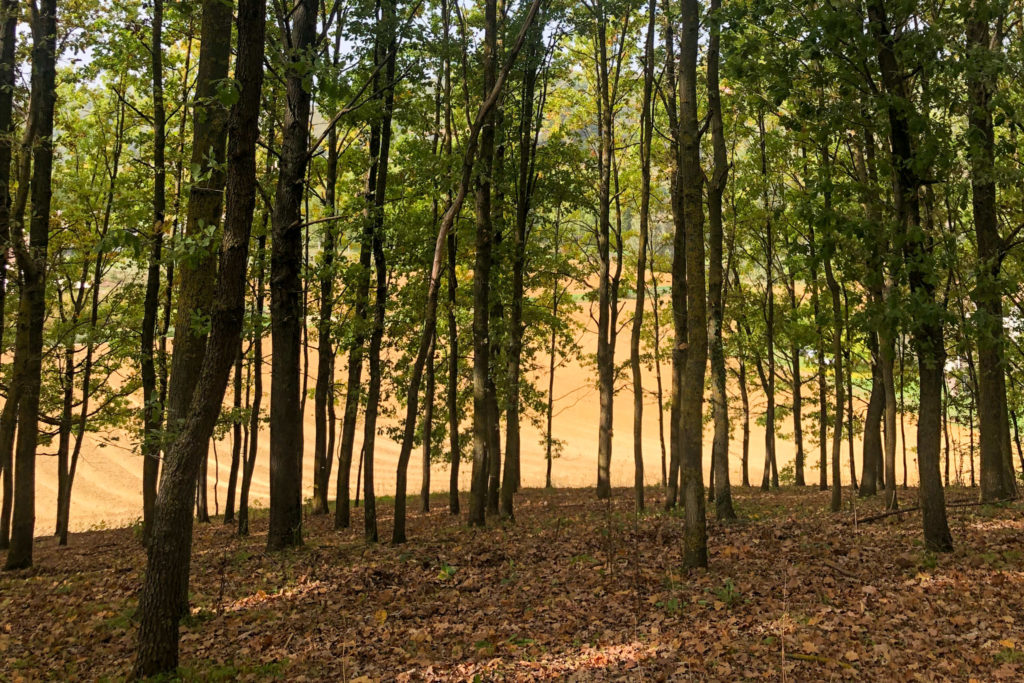
Summer truffles, Tuber aestivum, grow in summer and autumn. They have a subtler flavour, which works well with summer dishes. Summer truffles have a dark, lumpy exterior and tan-coloured flesh. They are the most affordable of the truffle varieties.
But the rarest and most prized of all are the Italian white truffles, Tuber magnatum pico. Unlike the black truffle, this one is impossible to cultivate and only thrives in damp, cool woodland. None are more sought-after than the Alba white truffle from Piedmont. Known as the diamond of Alba, these unassuming blobs of fungi are considered the finest truffles of all – and they really do fetch big money. A white truffle sold for more than 100,000 euros at autumn’s white truffle fair in the city of Alba. Even small truffles at the Alba market can cost 100 euros or more.
As the climate in Europe gets hotter and drier and some forests are destroyed in favour of crops, so the white truffle is getting even rarer.
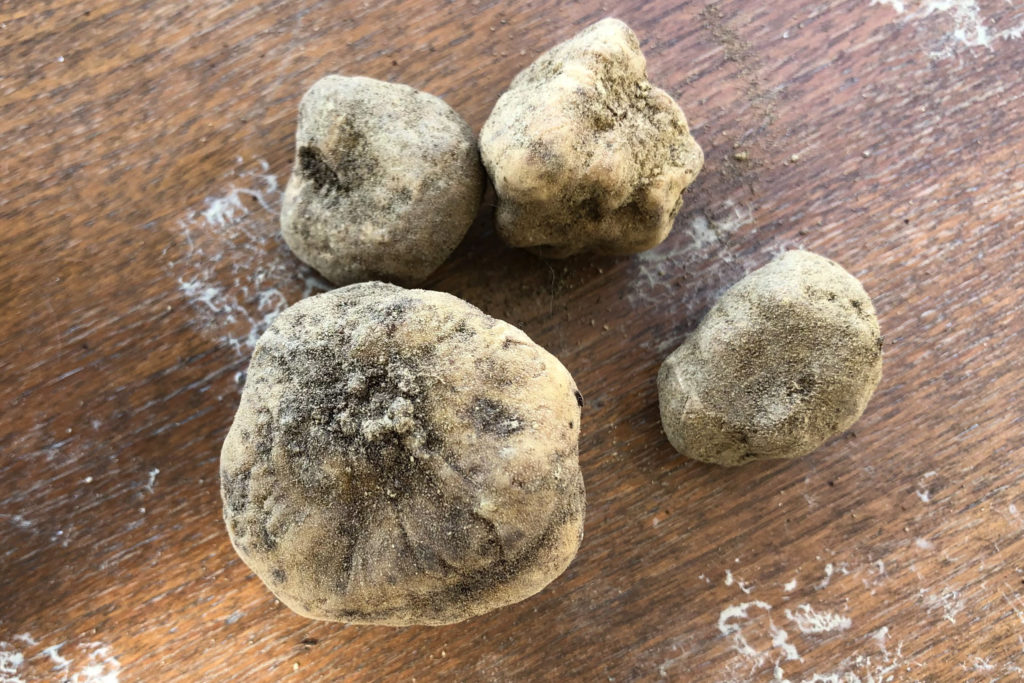
The white truffle has an irregular shape, ivory or yellowish surface and tender creamy coloured flesh. It’s scent is complex and heady and it has a umami-like taste. As heat compromises the flavour it’s eaten raw, shaved finely over pasta, egg dishes or risotto.
NB Know that truffle flavourings, rather than the real thing, are often used commercially for truffle-based products. If you want to taste a genuine truffle then it’s best to go as near as you can to the source since truffles don’t travel or store well. The perfect reason to go truffle hunting in Italy!
How to find truffles
Since the best way to find a truffle is by smell, every professional truffle hunter needs a well-trained four-legged friend to help sniff them out. Traditionally, female pigs were used for the hunt as the scent of the truffle contains androstenol, a pheromone found in male pigs. But pigs are difficult to train and it’s hard to stop them eating the truffles they find! Nowadays truffle pigs are banned in Italy as their digging can destroy the truffle’s habitat. So instead, professional truffle hunters rely on elite, carefully trained truffle dogs.
When is truffle season in Italy?
The Italian truffle season extends across the year as different varieties of truffle come in and out of season. And some varieties are only available during a short window of opportunity. The region of Piedmont has a calendar which dictates when each variety can be harvested and sold in markets, shops and restaurants. This protects the life cycle of the truffle species. You can find the calendar here . Make sure to check it before you start planning your truffle hunting in Italy.
The winter black truffle is found in several areas of Italy, including Emilia Romagna, Le Marche, Tuscany, Abruzzo and Molise, as well as Piedmont. It is harvested between November and February in Piedmont.
The white truffle season in Italy starts on 21 September and runs to the end of December although some years they are still found in January. If you visit Alba in November you could go truffle hunting and visit the International White Truffle Fair.
The more common summer black and white truffles can be found from spring through to autumn in Piedmont.
A white truffle hunt in Italy
Autumn and early winter is the time to experience a white truffle hunt in Piedmont. And several companies organise local tours. Luckily for me, Julia Barnaby of Piedmont Food and Wine invited me to join her for my first truffle hunting experience in November. Find out more about their tours here
We were a small group, only five of us, including Julia and Gino the hunter, plus his dog Bobby. Julia often picks up guests at their hotel and drives them to the meeting point. But as I live nearby I joined them at Gino’s farm just outside the village of Mombercelli, near Asti.
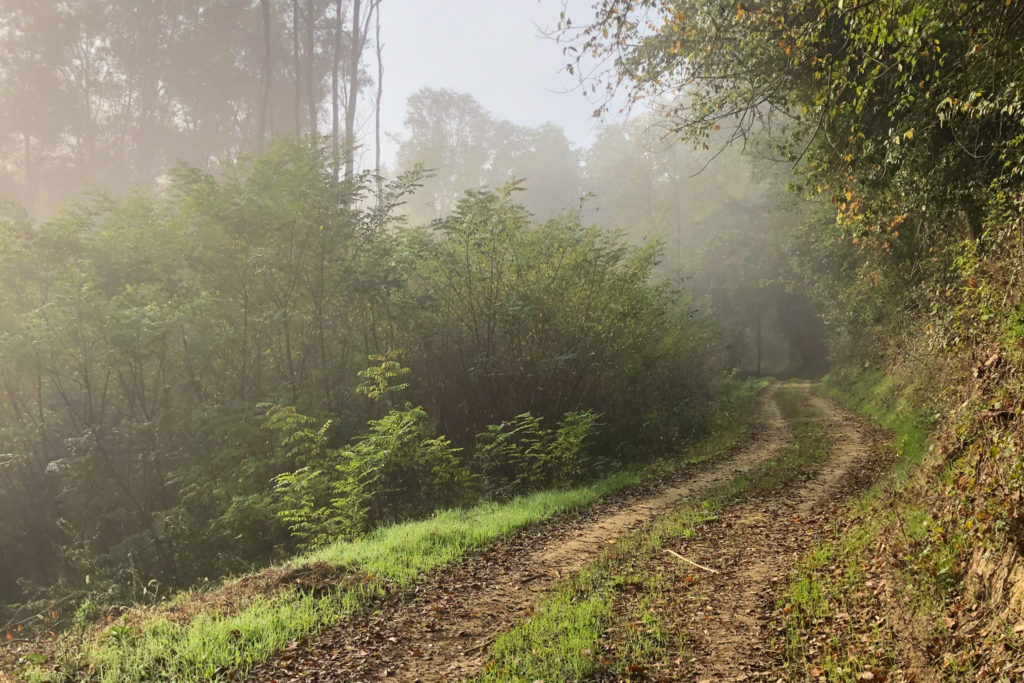
The time? A very respectable 11am, though some hunts do start in the early morning. And it’s often true that the early hunter gets the truffle. Most hunters are notoriously tight-lipped about their favourite locations. These are closely guarded secrets and some hunters even prefer foraging under the cover of darkness.
Gino, now 67, has been a truffle hunter for more than four decades using skills passed down to him from his father and grandfather. His farm has been in his family for generations too. And he isn’t just a truffling legend, he also produces some of the best wines in the region.
After brief introductions, we set off on foot to Gino’s favourite patch of woodland for a morning of truffle hunting. The air was misty but dry. A carpet of autumn leaves, wet from the previous night’s rain, covered the forest floor. It was a good sign: truffles need moisture. And this year, after the driest summer on record, they’re even rarer than usual. ‘It’s been 12 days since I’ve found one,’ Gino told me. But he was hopeful that today was the day we’d strike ‘white gold’.
Truffle hunting in woodland
Gino and Bobby led the way into the woods. Bobby was on a long rope, circling and sniffing whilst Gino offered words of encouragement. Then astonishingly, within minutes, Bobby started digging furiously under a hazelnut tree. We stood around watching excitedly, as Gino handed the rope to Julia and got down on his hands and knees beside the dog. He grabbed a handful of soil – and then thrust it under my nose. The smell? Earthy, musky, mega-mushroomy, unmistakably the smell of truffle: proof that, yes, we really had struck fungi gold. Gino dug carefully around the soil with a small hoe and unearthed what looked like a little wrinkly potato. Our first white truffle! Gino gave Bobby a treat and tenderly pocketed the truffle in a fabric bag.
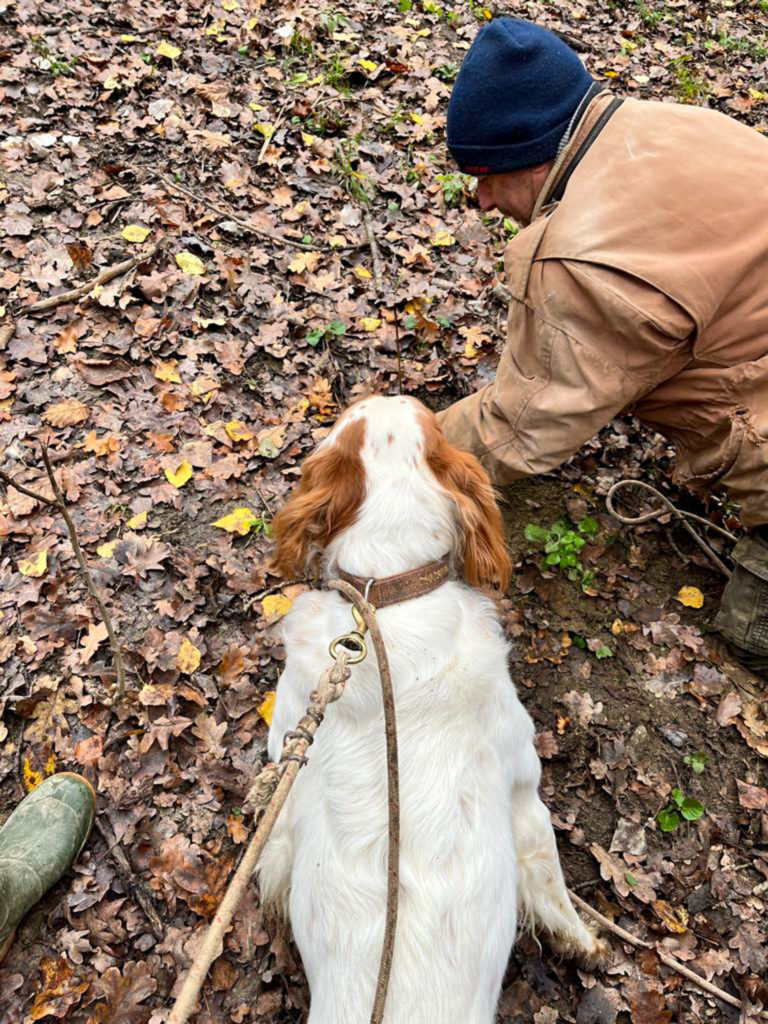
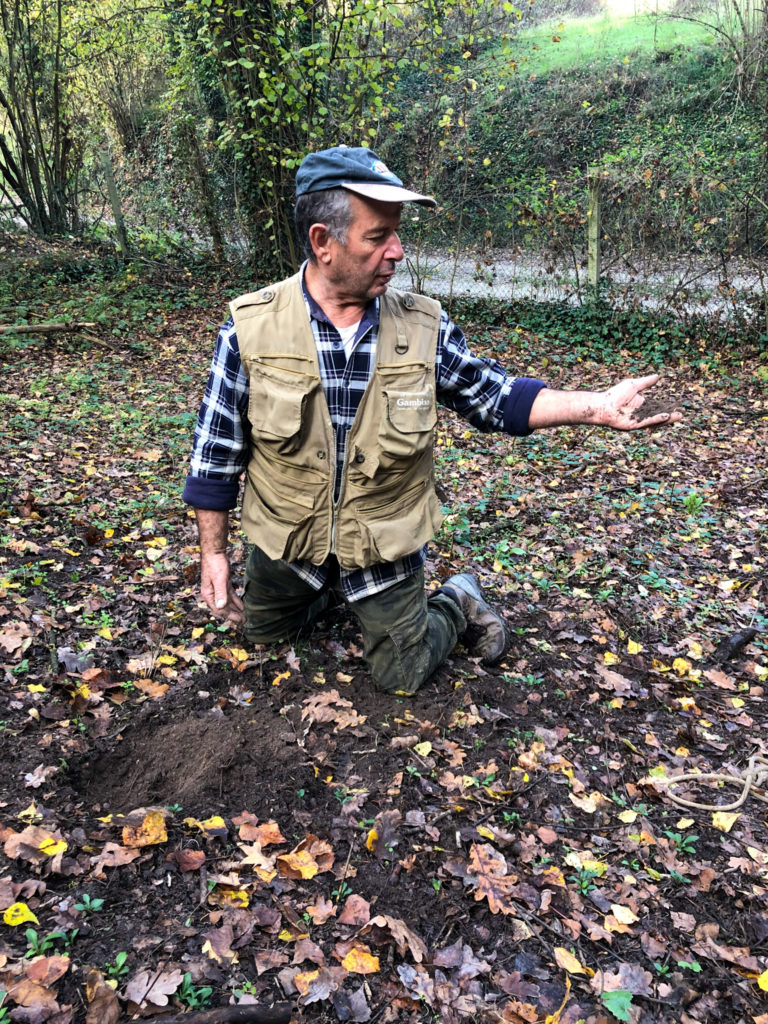
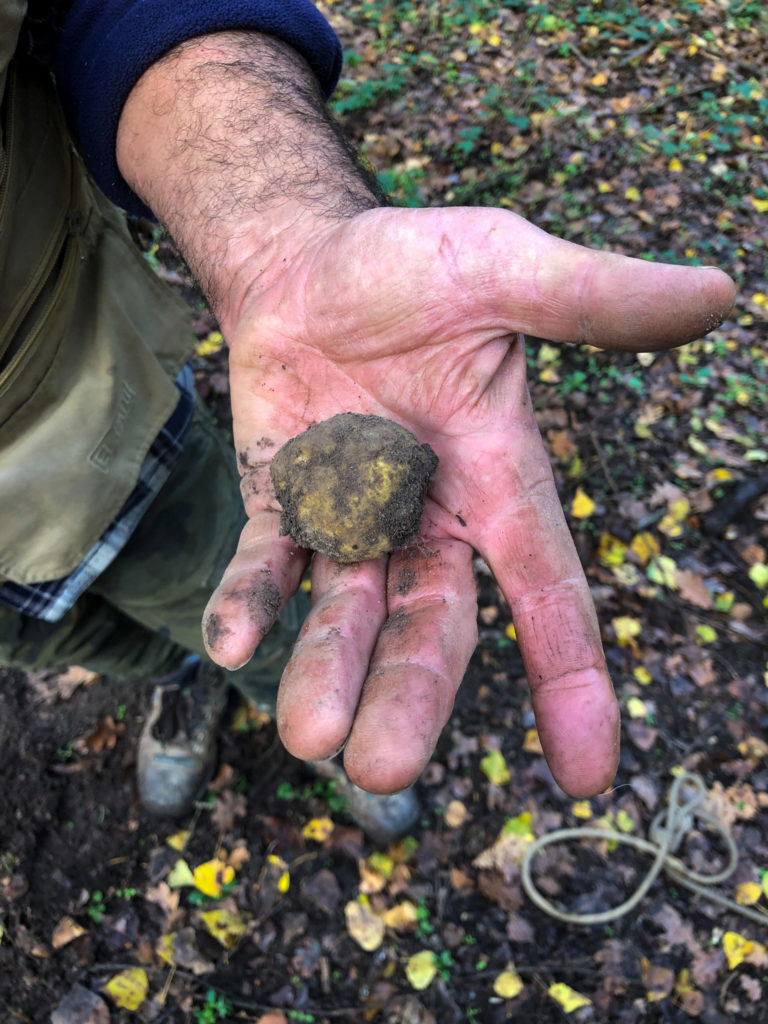
TRUFFLE HUNTING DOGS Gino’s truffle dog Bobby is a five-year-old setter cross, although the curly-haired lagotto romagnolo breed of dog is also popular for truffle hunting in Italy. Gino says it only took a few months to train Bobby. He began by planting bits of gorgonzola cheese around the farmyard, which Bobby enjoyed finding and eating. According to Gino, a dog can quickly adapt from sniffing out the strong scent of cheese to the pungent smell of truffle. Importantly, the next step in training was to make sure Bobby didn’t eat the truffles he found. Gino gives him dog biscuits instead which, luckily, he prefers. Bobby is now a valuable asset. A fully trained truffle dog can cost as much as 5,000 euros.
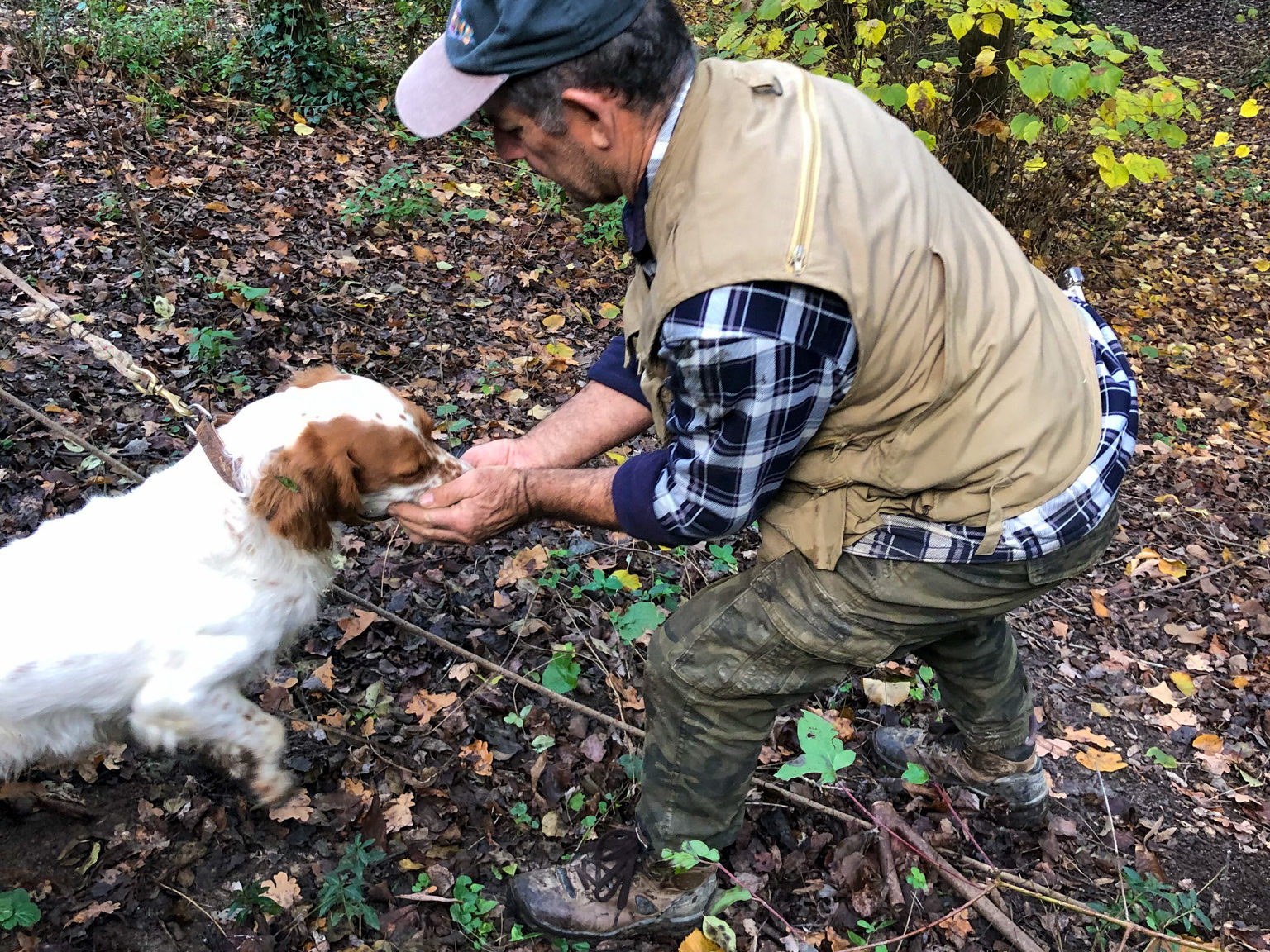
For the next hour or so we followed Gino and Bobby through the forest in pursuit of more knobbly nuggets. Not easy at times. For a man in his late 60s who’d once been told he may not walk again after a farming accident, Gino is a truffle-hunting superhero. He and Bobby scooted around the woodlands at record speed, with the rest of us slipping and stumbling after them.
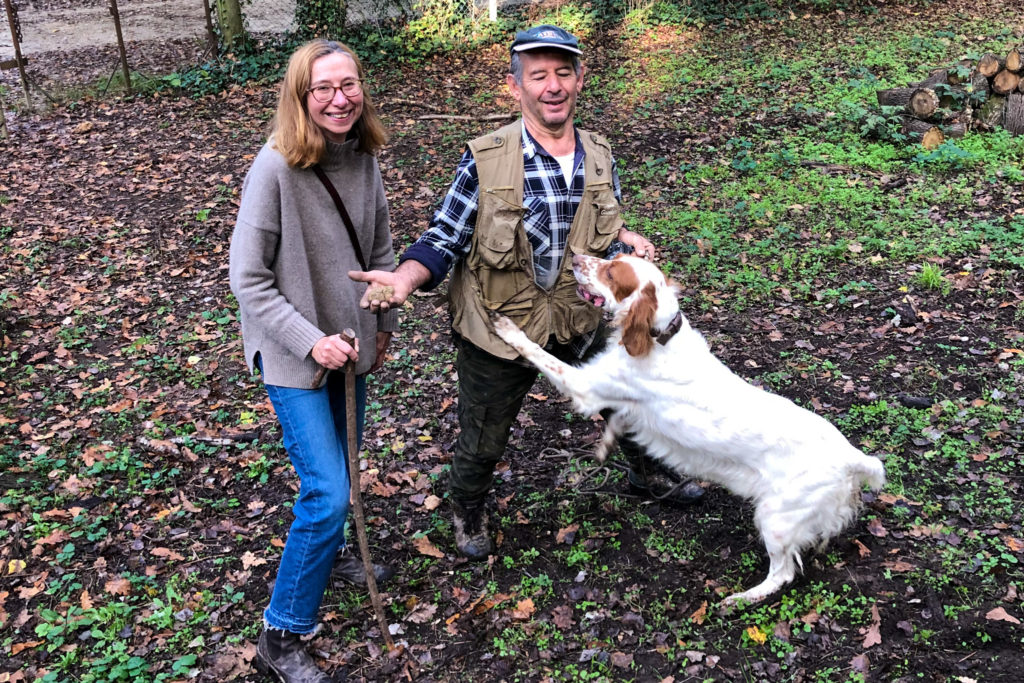
WHAT TO WEAR FOR A TRUFFLE HUNT Comfortable clothing is key for your Italian truffle hunting experience. You may find yourself scrambling up some pretty steep ascents, so the right footwear is very important. Either trainers or walking boots with good grip are best. Jeans or long trousers are a must and socks are important as there can be ticks and biting insects in the woods. And think layers: the day we went truffle hunting started out chilly, but after a few rounds of the forest, we soon warmed up.
You don’t have to be super-fit to go on a hunt, but be prepared for a bit of a workout. And, boy, was it worth it for us: we found three more decent-sized white truffles, which, along with that first treasure, Julia said would be worth 300 euros.
So what did we do with our prized white truffles? We ate them, of course.
Truffles and fine wine
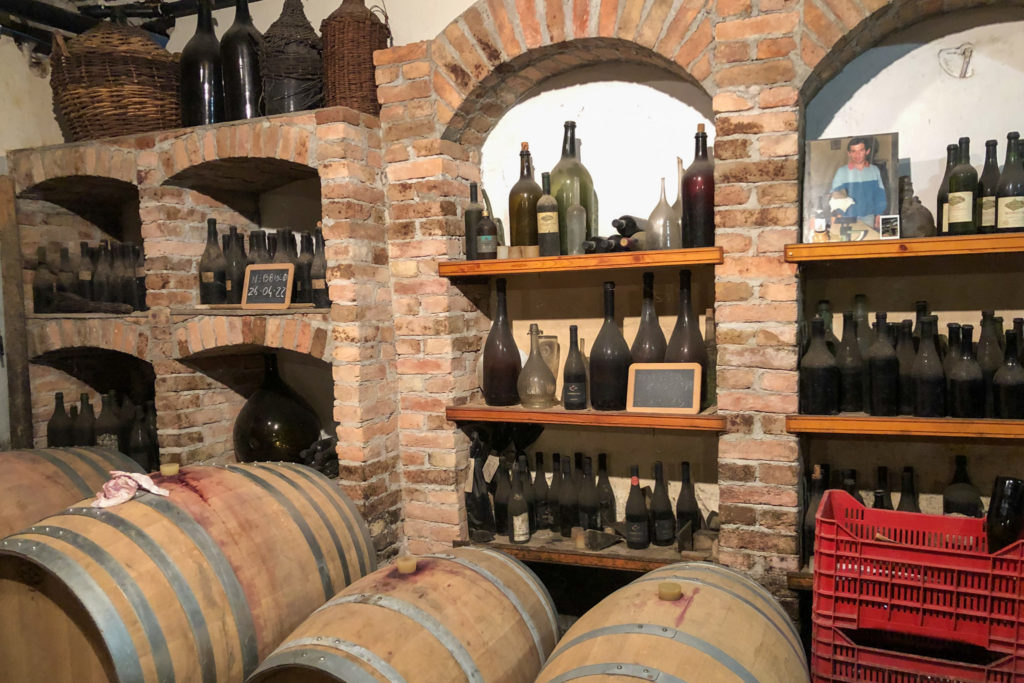
But first, back at the farmhouse, Gino took us on a tour of his wine cellar. We tasted the wines that are currently maturing, starting with a young 2021 Barbera D’Asti. Perfectly drinkable, I thought appreciatively, until I tasted a Barbera that Gino has aged in French oak barrels for several years. It was fascinating to see the difference. The mature wine was smooth, full-bodied and bursting with red fruit notes. Some of Gino’s wines have the high quality DOCG classification and it shows.
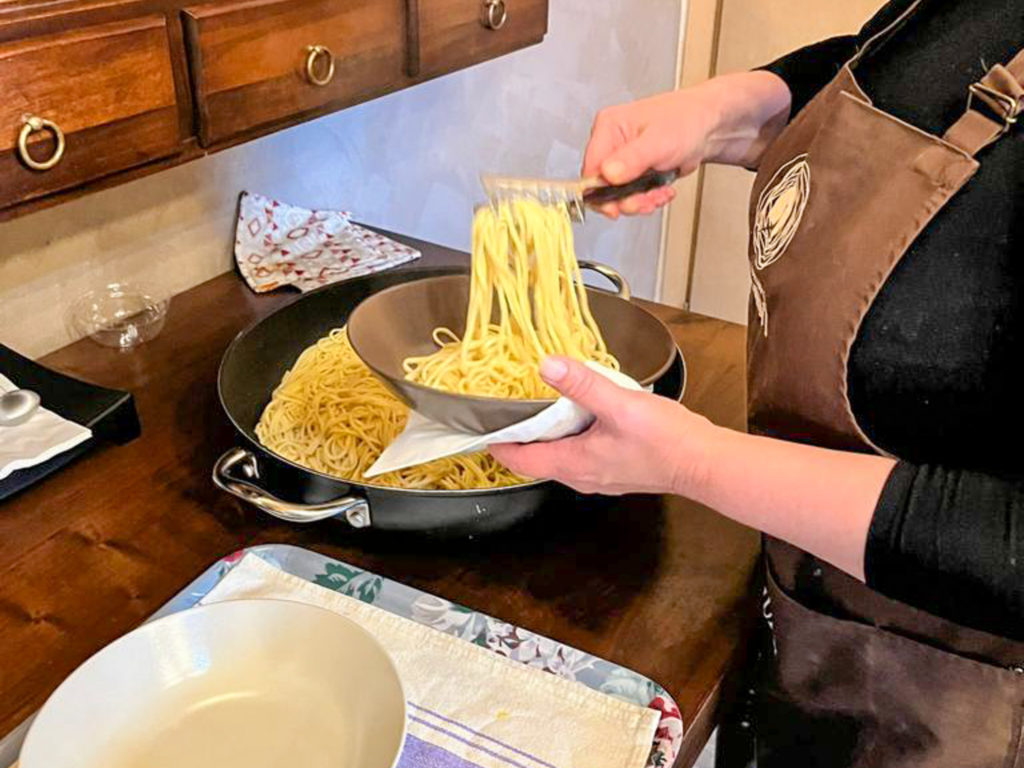
Next the focus turned to Gino’s wife Larissa who cooked a lunchtime feast to accompany Gino’s wines. First on the table she handed round focaccia with salami, a porcini mushroom flan and raw seasonal vegetables with the Piedmontese speciality bagna cauda. Then she followed up with the star of the show: homemade tajarin pasta, a local dish, with shavings of our freshly picked white truffles. Who’d have thought a simple bowl of pasta could taste so divine? Pudding was panna cotta and semifreddo with torrone, a hazelnut nougat.
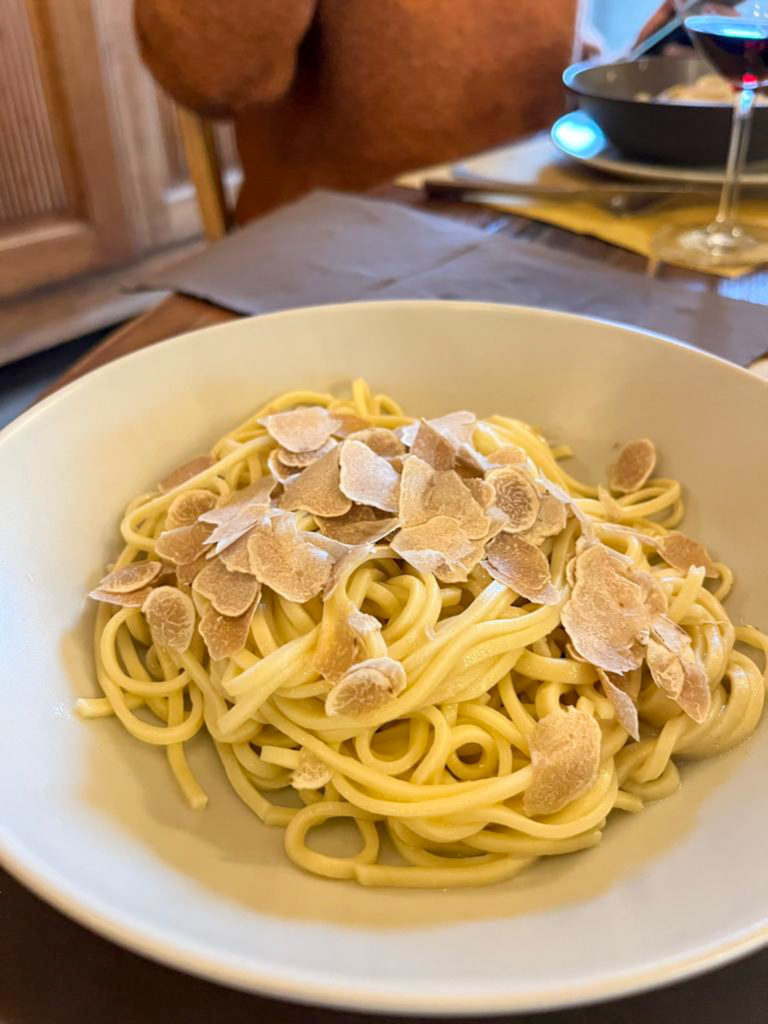
Truffle festivals in Alba and Piedmont
Hunting for truffles in Italy during the autumn months doesn’t have to involve a dog and a forest. From October to December, the beautiful medieval city of Alba hosts an international white truffle festival, which takes place every weekend. It attracts truffle experts and truffle lovers from across the world. Activities such as concerts and historical re-enactments take place across the city. But the truffle fair itself is in an enormous tent (the 15 euros entrance fee includes two wine tastings). There are what seems like hundreds of stalls selling regional culinary delicacies, local cheeses, seasonal produce and, of course, white truffles of every shape and size, which are sold directly to the public by the truffle hunters. The fair also holds cookery demonstrations, truffle analysis lessons and guided wine tastings.
Local truffle fairs
You’ll also find truffle fairs in one or other of the region’s towns and villages every weekend during the autumn months, including Moncalvo, Canelli and Asti. The Regione Piemonte website has a calendar of local fairs and events.
This year we went to the festival in our local village of Mombercelli. It’s a serious day out for the locals with a competition for the best truffle plus stalls selling every type of local produce. We browsed the stalls amongst weirdly shaped pumpkins and the longest leeks I’ve ever seen, along with cheeses, salume, wine, olive oil, honey and, of course, white truffles. The truffles are kept under lidded glass bell jars. When you go to a stall to admire the truffles or perhaps to buy, the stallholder will lift up the lid of a jar. It’s then that you get a big lungful of the intense earthy smell.
There’s plenty going on to entertain visitors such as wine tastings and lunch stalls with delicious hot dishes from food cooperatives. You’ll be tempted to try pasta ‘con tartufo’!
Add a blues’y cover band playing in the background and some serious Campari cocktails and it’s like an English village fair on steroids.
Plan a truffle experience in Piedmont
You could easily spend an unforgettable few days truffle hunting in Italy in the winter months.
The region is a foodie paradise with one of the highest concentrations of top quality restaurants in the whole of Italy. It has no less than 46 Michelin starred restaurants.
It is also home to some of Italy’s most famous and respected wines including Barbera, Barolo, Barbaresco, Gavi and Asti Spumante. There are almost 18,000 wineries across the region.
So, why not book a luxury hotel (or an Airbnb!). Arrange to go on a truffle hunting expedition to watch first hand the skilled work of hunter and dogs. And make a reservation at one or more of the restaurants in the region that offer seasonal truffle menus. This way you can try a variety of truffle dishes alongside the great wine varieties of Piedmont.
If you splash out and choose a Michelin star restaurant you’ll have the unique experience of sampling a top chef’s culinary creativity using the ‘diamond of the kitchen’: the finest truffles, freshly picked.
Add a wine tasting experience, a visit to one of the local truffle markets, even a cookery class, and you have a very special gourmet getaway.
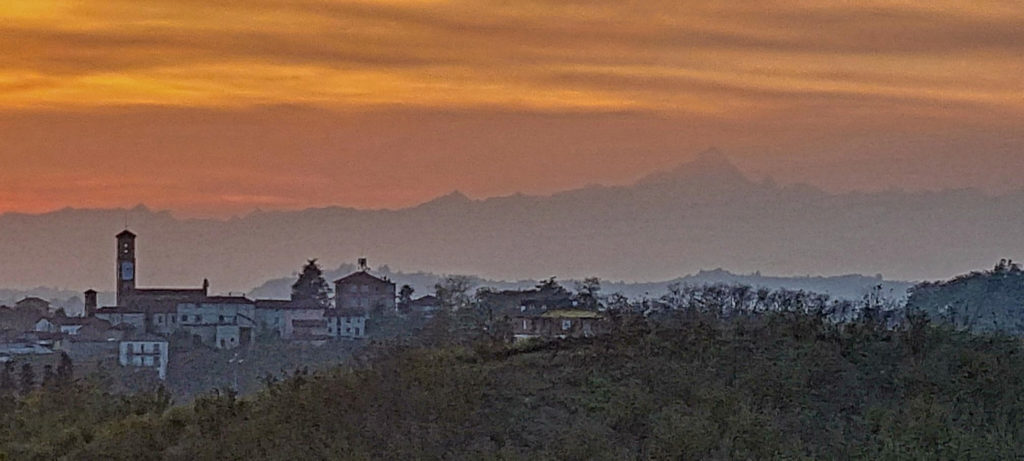
Where to Stay in Piedmont
You’ve decided you need to visit Piedmont to experience for yourself its unique and authentic Italian country life. Now for some wonderful places to stay in the Monferrato region of Piedmont. This selection has somewhere for everyone. All are well recommended and have exceptional reviews. Check them out by clicking the links to Booking.com.
Our selection of lovely places to stay in Piedmont
For one of the ritziest of stays in the area, Castello di Guarene ticks all the boxes. An 18th century hilltop castle with manicured grounds, it provides the perfect backdrop for a search for the most coveted truffles in the world. It’s just a 12 minute drive from Alba. Click here to check availability and to book Castello di Guarene.
Or Relais San Maurizio, a former 17th century monastery, with a medical spa and its own Michelin star restaurant serving specialities of Piedmont. Click here to check availability and to book Relais San Maurizio.
Villa Giara in Calosso is a great find. Click here to read a review of my stay. A boutique hotel which prioritises hospitality and a stylish, refined vibe. It offers wi-fi, air conditioning, an outdoor pool and magical panoramic views. Click here to check availability and to book Villa Giara.
Casa del Roseto is a charming guesthouse in Catherine’s village of Belveglio. A carefully renovated traditional farmhouse it has a lovely English-style garden surrounded by vineyards and meadows. Rooms have wi-fi and flat screen TVs, there’s an outdoor swimming pool and breakfast is included. Click here to check availability and to book Casa del Roseto.
If you prefer to be self-catering, Catherine also rents her Italian home Cascina Caterina, from June to mid-September each year. This secluded farmhouse in lovely countryside sleeps 8 and has an outdoor pool. It does get booked up quickly but for more details: https://abnb.me/V94yKMdFPvb or DM Catherine on Instagram https://www.instagram.com/cascinacaterinaitaly/
HOW TO GO TRUFFLE HUNTING IN ITALY
DISCLOSURE Catherine went truffle hunting as a guest of Piedmont Food and Wine. Julia and Simon Barnaby are a British couple who have been working in Piedmont for 15 years. They started their company to share their love of the region and its unique food and wine culture and are personal friends with many of the local experts who feature in their food and wine tours.
Julia can arrange bespoke white truffle hunts for small groups or individuals with an expert truffle hunter and English-speaking guide from late September to December. Across much of the rest of the year they offer winter black or summer truffle hunting.
A half-day truffle hunt with wine-tasting and antipasti including truffles, local cheeses and salami costs 75 euros per person. A truffle hunt with a wine tasting and lunch costs from 200 euros per person. For further information contact Julia at piedmont-foodandwine.com and mention this blog post.

Catherine is a journalist who divides her time between London and Piedmont. You can follow her life in Italy on her Instagram account @cascinacaterinaitaly
What to read next
Check in to Villa Giara a boutique Italian B&B you’ll love in the heart of Piedmont.
Discover what makes the Piedmont region of Italy quite so special. Hint: perhaps it’s the food, wine, gorgeous green views, beautiful towns and villages, gentle pace of life, truffles, chocolate….
Read Catherine’s post about visiting Turin and the Italian Lakes here.
Visiting Florence? Read about our stay in an authentic and affordable boutique hotel In Piazza della Signoria
Please note that all visitor information here is for guidance only. Please check the relevant websites for the most up to date information eg. accommodation details, tickets, entrance requirements, opening times etc.
All photos are all rights reserved. Please do not reproduce these photos without prior written permission
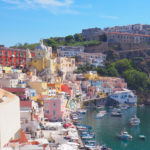
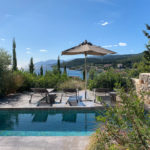
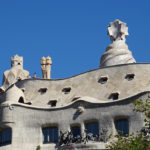
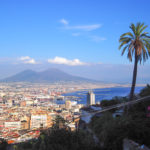
Leave a Reply